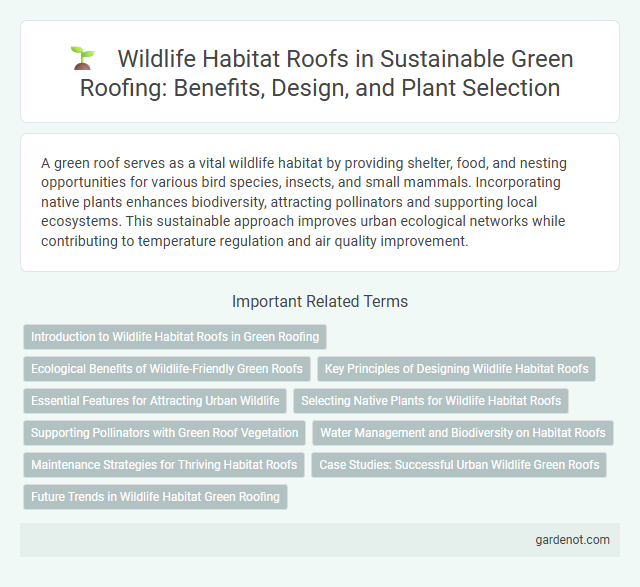A green roof serves as a vital wildlife habitat by providing shelter, food, and nesting opportunities for various bird species, insects, and small mammals. Incorporating native plants enhances biodiversity, attracting pollinators and supporting local ecosystems. This sustainable approach improves urban ecological networks while contributing to temperature regulation and air quality improvement.
Introduction to Wildlife Habitat Roofs in Green Roofing
Wildlife habitat roofs transform traditional rooftops into biodiverse ecosystems that support various species, promoting urban biodiversity and ecological balance. These green roofs incorporate native plants, nesting sites, and water features tailored to attract pollinators, birds, and insects. Implementing wildlife habitat roofs contributes to habitat restoration, improves air quality, and mitigates urban heat island effects in densely populated areas.
Ecological Benefits of Wildlife-Friendly Green Roofs
Wildlife-friendly green roofs provide essential habitats for urban biodiversity, supporting pollinators like bees and butterflies while offering refuge for birds and small mammals. These roofs enhance ecological connectivity by creating green corridors that facilitate species movement across fragmented urban landscapes. Their diverse plantings improve air quality, reduce urban heat island effects, and promote nutrient cycling, contributing to healthier urban ecosystems.
Key Principles of Designing Wildlife Habitat Roofs
Designing wildlife habitat roofs centers on creating diverse plant layers that mimic natural ecosystems to support local fauna and promote biodiversity. Incorporating native vegetation, providing water sources, and ensuring structural variety enhance shelter and foraging opportunities for birds, insects, and small mammals. Proper soil depth, drainage, and minimal human disturbance are crucial to sustain healthy habitats and ecological balance on green roofs.
Essential Features for Attracting Urban Wildlife
A wildlife habitat roof must include native plant species to provide food and shelter for urban wildlife such as birds, bees, and butterflies. Incorporating diverse vegetation layers and water sources supports nesting and hydration needs, enhancing biodiversity. Structural elements like logs or stones create safe refuges, encouraging species to thrive in the urban ecosystem.
Selecting Native Plants for Wildlife Habitat Roofs
Selecting native plants for a wildlife habitat roof enhances local biodiversity by providing essential food and shelter for birds, insects, and small mammals. Native species require less maintenance and water, adapting naturally to the urban environment, which supports ecological balance and improves roof longevity. Incorporating a diverse mix of native wildflowers, grasses, and shrubs fosters a resilient ecosystem that promotes pollination and natural pest control.
Supporting Pollinators with Green Roof Vegetation
Green roofs designed as wildlife habitats provide essential support to pollinators by incorporating native flowering plants that offer nectar and pollen throughout the growing season. These green roof vegetation systems create refuges for bees, butterflies, and other beneficial insects, promoting biodiversity in urban environments. By enhancing pollinator habitats, green roofs contribute to the sustainability and resilience of local ecosystems.
Water Management and Biodiversity on Habitat Roofs
Habitat roofs enhance urban biodiversity by providing essential water management through natural absorption and retention systems that reduce runoff and promote groundwater recharge. These green roofs create microhabitats supporting diverse flora and fauna, including pollinators, birds, and insects, which contribute to ecosystem resilience. Effective water retention layers and native plant selection optimize habitat sustainability, balancing ecological benefits with stormwater control.
Maintenance Strategies for Thriving Habitat Roofs
Regular inspections and native plant care promote thriving wildlife habitat roofs by supporting local biodiversity and pollinators. Seasonal pruning and controlled irrigation balance plant health and water conservation while preventing invasive species. Integrating organic mulch and monitoring soil quality ensures optimal nutrition and sustainable ecosystem growth on green roofs.
Case Studies: Successful Urban Wildlife Green Roofs
Urban wildlife green roofs demonstrate significant ecological benefits, as seen in case studies like the Chicago City Hall roof, which supports native pollinators and bird species. Research from the Vancouver Convention Centre green roof highlights improved biodiversity by incorporating diverse native plant species and habitat structures. These successful projects underscore the capacity of green roofs to create vital urban wildlife habitats while enhancing ecosystem services in dense city environments.
Future Trends in Wildlife Habitat Green Roofing
Emerging trends in wildlife habitat green roofing emphasize integrating native plant species to enhance biodiversity and support local ecosystems more effectively. Advancements in sensor technology and smart irrigation systems optimize water use and plant health, promoting sustainable habitat conditions. Increasing urban planning policies are encouraging multifaceted green roofs that serve both ecological and social functions, reflecting a shift towards resilient, climate-adaptive infrastructure.
Wildlife habitat roof Infographic

 gardenot.com
gardenot.com